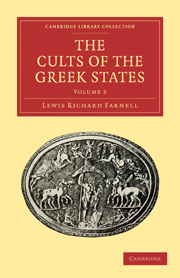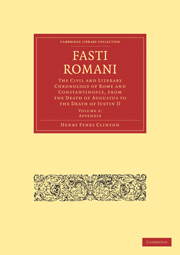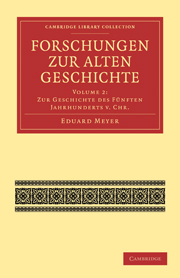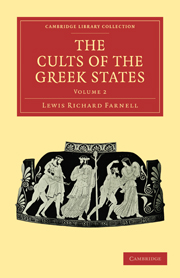Refine search
Actions for selected content:
23990 results in Ancient history

The Cults of the Greek States
-
- Published online:
- 03 May 2011
- Print publication:
- 15 July 2010
- First published in:
- 1909

The Cults of the Greek States
-
- Published online:
- 03 May 2011
- Print publication:
- 15 July 2010
- First published in:
- 1907

Fasti Romani
- The Civil and Literary Chronology of Rome and Constantinople, from the Death of Augustus to the Death of Justin II
-
- Published online:
- 03 May 2011
- Print publication:
- 31 October 2010
- First published in:
- 1850

Forschungen zur Alten Geschichte
-
- Published online:
- 03 May 2011
- Print publication:
- 19 August 2010
- First published in:
- 1899

The Cults of the Greek States
-
- Published online:
- 03 May 2011
- Print publication:
- 15 July 2010
- First published in:
- 1896

Law, Sexuality, and Society
- The Enforcement of Morals in Classical Athens
-
- Published online:
- 03 May 2011
- Print publication:
- 03 October 1991
9 - REMEMBERING MAXENTIUS
-
- Book:
- Remembering Constantine at the Milvian Bridge
- Published online:
- 03 May 2011
- Print publication:
- 29 April 2011, pp 224-252
-
- Chapter
- Export citation
INDEX
-
- Book:
- Remembering Constantine at the Milvian Bridge
- Published online:
- 03 May 2011
- Print publication:
- 29 April 2011, pp 289-296
-
- Chapter
- Export citation
Constantines Empire After 312
-
- Book:
- Remembering Constantine at the Milvian Bridge
- Published online:
- 03 May 2011
- Print publication:
- 29 April 2011, pp xiv-xiv
-
- Chapter
- Export citation
ABBREVIATIONS
-
- Book:
- Remembering Constantine at the Milvian Bridge
- Published online:
- 03 May 2011
- Print publication:
- 29 April 2011, pp xi-xi
-
- Chapter
- Export citation
8 - BACKWARD AND FORWARD
-
- Book:
- Remembering Constantine at the Milvian Bridge
- Published online:
- 03 May 2011
- Print publication:
- 29 April 2011, pp 219-223
-
- Chapter
- Export citation
TIMELINE
-
- Book:
- Remembering Constantine at the Milvian Bridge
- Published online:
- 03 May 2011
- Print publication:
- 29 April 2011, pp xii-xiii
-
- Chapter
- Export citation
4 - CONSTANTINE'S MEMORIES
-
- Book:
- Remembering Constantine at the Milvian Bridge
- Published online:
- 03 May 2011
- Print publication:
- 29 April 2011, pp 56-81
-
- Chapter
- Export citation
Frontmatter
-
- Book:
- Remembering Constantine at the Milvian Bridge
- Published online:
- 03 May 2011
- Print publication:
- 29 April 2011, pp i-vi
-
- Chapter
- Export citation
2 - THE AFTERLIFE OF CONSTANTINE
-
- Book:
- Remembering Constantine at the Milvian Bridge
- Published online:
- 03 May 2011
- Print publication:
- 29 April 2011, pp 19-32
-
- Chapter
- Export citation
PREFACE
-
- Book:
- Remembering Constantine at the Milvian Bridge
- Published online:
- 03 May 2011
- Print publication:
- 29 April 2011, pp ix-x
-
- Chapter
- Export citation
BIBLIOGRAPHY
-
- Book:
- Remembering Constantine at the Milvian Bridge
- Published online:
- 03 May 2011
- Print publication:
- 29 April 2011, pp 267-288
-
- Chapter
- Export citation
5 - EUSEBIUS' COMMENTARY
-
- Book:
- Remembering Constantine at the Milvian Bridge
- Published online:
- 03 May 2011
- Print publication:
- 29 April 2011, pp 82-100
-
- Chapter
- Export citation
6 - SHAPING MEMORIES IN THE WEST
-
- Book:
- Remembering Constantine at the Milvian Bridge
- Published online:
- 03 May 2011
- Print publication:
- 29 April 2011, pp 101-154
-
- Chapter
- Export citation
EDITIONS AND TRANSLATIONS
-
- Book:
- Remembering Constantine at the Milvian Bridge
- Published online:
- 03 May 2011
- Print publication:
- 29 April 2011, pp 259-266
-
- Chapter
- Export citation
